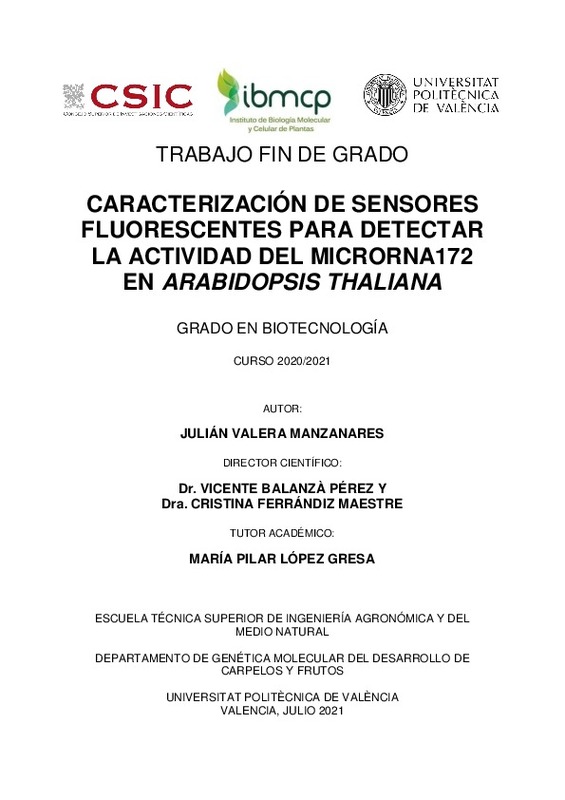JavaScript is disabled for your browser. Some features of this site may not work without it.
Buscar en RiuNet
Listar
Mi cuenta
Estadísticas
Ayuda RiuNet
Admin. UPV
Caracterización de sensores fluorescentes para detectar la actividad del microRNA172 en Arabidopsis thaliana
Mostrar el registro sencillo del ítem
Ficheros en el ítem
| dc.contributor.advisor | López Gresa, María Pilar
|
es_ES |
| dc.contributor.advisor | Balanzá Pérez, Vicente
|
es_ES |
| dc.contributor.author | Valera Manzanares, Julián
|
es_ES |
| dc.date.accessioned | 2021-07-30T14:43:36Z | |
| dc.date.available | 2021-07-30T14:43:36Z | |
| dc.date.created | 2021-07-14 | |
| dc.date.issued | 2021-07-30 | es_ES |
| dc.identifier.uri | http://hdl.handle.net/10251/171062 | |
| dc.description.abstract | [ES] Los microRNA (miRNA) son secuencias cortas de 21 nucleótidos que actúan como reguladores de la expresión de sus genes diana en los organismos eucariotas. Estos miRNA reconocen secuencias complementarias en los RNA mensajeros (mRNA) de sus dianas. En plantas, los miRNA regulan la expresión de sus dianas a dos niveles. Los miRNA pueden dirigir la degradación de sus mRNA dianas través de una escisión inicial en el sitio de reconocimiento presente en ellos, o también, impedir la traducción del mRNA diana a través de un mecanismo que todavía no esta muy bien descrito en plantas. Para la gran mayoría de dianas de miRNA se ha observado que los dos mecanismos coexisten, y que, para algunas dianas en concreto, la inhibición de la traducción juega un papel principal. Este es el caso del miR172 que regula un grupo de factores de transcripción de la familia AP2 y que están implicados en múltiples procesos de desarrollo en plantas. En el grupo donde se va ha realizar este TFG estudian los mecanismos a través de los cuales se controla el final de la floración, un proceso que tiene claras implicaciones en el rendimiento de muchas especies de interés agronómico: el retraso temporal del final de la floración supone un incremento en el numero de flores, frutos y semillas, que incrementa la producción final. En el control del final de la floración juegan un papel clave las proteínas AP2s, y la regulación ejercida por el miR172 sobre estos genes. El objetivo de este TFG es testar y caracterizar diferentes sensores de la actividad del miR172 que permitan evaluar su presencia y, por lo tanto, la acumulación de sus dianas en los tejidos donde ejercen su función. Estos sensores se testarán inicialmente mediante expresión transitoria en A. thaliana y Nicotiana benthamiana, y posteriormente se generarán plantas transgénicas de A. thaliana y se analizará su eficacia por microscopía confocal. | es_ES |
| dc.description.abstract | [EN] MicroRNAs (miRNAs) are short sequences of 21 nucleotides that act as regulators of the expression of their target genes in eukaryotic organisms. These miRNAs recognize complementary sequences in the messenger RNAs (mRNAs) of their targets. In plants, miRNAs regulate the expression of their targets at two levels. The miRNAs can either direct the degradation of their target mRNAs through an initial cleavage in the recognition site present in them, or prevent the translation of the target mRNA through a mechanism that is not yet well described in plants. For the vast majority of miRNA targets, it has been observed that the two mechanisms coexist, and for some specific targets, inhibition of translation plays a major role. This is the case of miR172 that regulates a group of transcription factors of the AP2 family and that are involved in multiple development processes in plants. In the group where this project is going to be carried out, they study the mechanisms through which the end of flowering is controlled, a process that has clear implications in the performance of many species of agronomic interest: the temporary delay of the end of flowering. It supposes an increase in the number of flowers, fruits and seeds, which increases the final production. AP2s proteins play a key role in the control of the end of flowering, and the regulation exerted by miR172 on these genes. The objective of this project is to test and characterize different sensors of miR172 activity that allow evaluating its presence and therefore, the accumulation of its targets in the tissues where they perform their function. These sensors will be initially tested by transient expression in A. thaliana and Nicotiana benthamiana, and later transgenic A. thaliana plants will be generated and their effectiveness will be analyzed by confocal microscopy. | es_ES |
| dc.format.extent | 33 | es_ES |
| dc.language | Español | es_ES |
| dc.publisher | Universitat Politècnica de València | es_ES |
| dc.rights | Reserva de todos los derechos | es_ES |
| dc.subject | Confocal microscopy | es_ES |
| dc.subject | MiRNA | es_ES |
| dc.subject | Arabidopsis thaliana | es_ES |
| dc.subject | Sensor | es_ES |
| dc.subject | Microscopía confocal | es_ES |
| dc.subject | Expresión transitoria | es_ES |
| dc.subject | Transient expression | es_ES |
| dc.subject.classification | BIOQUIMICA Y BIOLOGIA MOLECULAR | es_ES |
| dc.subject.other | Grado en Biotecnología-Grau en Biotecnologia | es_ES |
| dc.title | Caracterización de sensores fluorescentes para detectar la actividad del microRNA172 en Arabidopsis thaliana | es_ES |
| dc.type | Proyecto/Trabajo fin de carrera/grado | es_ES |
| dc.rights.accessRights | Abierto | es_ES |
| dc.contributor.affiliation | Universitat Politècnica de València. Departamento de Biotecnología - Departament de Biotecnologia | es_ES |
| dc.contributor.affiliation | Universitat Politècnica de València. Escuela Técnica Superior de Ingeniería Agronómica y del Medio Natural - Escola Tècnica Superior d'Enginyeria Agronòmica i del Medi Natural | es_ES |
| dc.description.bibliographicCitation | Valera Manzanares, J. (2021). Caracterización de sensores fluorescentes para detectar la actividad del microRNA172 en Arabidopsis thaliana. Universitat Politècnica de València. http://hdl.handle.net/10251/171062 | es_ES |
| dc.description.accrualMethod | TFGM | es_ES |
| dc.relation.pasarela | TFGM\143942 | es_ES |
Este ítem aparece en la(s) siguiente(s) colección(ones)
-
ETSIAMN - Trabajos académicos [3541]
Escuela Técnica Superior de Ingeniería Agronómica y del Medio Natural






